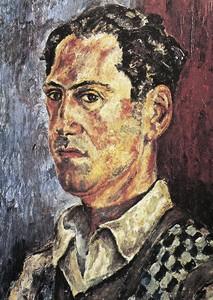Список картин Уильяма Тёрнера. Картины william turner
Список картин Уильяма Тёрнера - WikiVisually
1. Тёрнер, Уильям – Joseph Mallord William Turner, RA was an English Romanticist landscape painter. Turner was considered a figure in his day, but is now regarded as the artist who elevated landscape painting to an eminence rivalling history painting. Although renowned for his oil paintings, Turner is also one of the greatest masters of British watercolour landscape painting and he is commonly known as the painter of light. Joseph Mallord William Turner was baptised on 14 May 1775, and it is generally believed he was born between late April and early May. Turner himself claimed he was born on 23 April, but there is no proof and he was born in Maiden Lane, Covent Garden, in London, England. His father, William Turner, was a barber and wig maker and his mother, Mary Marshall, came from a family of butchers. A younger sister, Mary Ann, was born in September 1778, the earliest known artistic exercise by Turner is from this period—a series of simple colourings of engraved plates from Henry Boswells Picturesque View of the Antiquities of England and Wales. Around 1786, Turner was sent to Margate on the north-east Kent coast, here he produced a series of drawings of the town and surrounding area foreshadowing his later work. Turner returned to Margate many times in later life, by this time, Turners drawings were being exhibited in his fathers shop window and sold for a few shillings. His father boasted to the artist Thomas Stothard that, My son, in 1789, Turner again stayed with his uncle who had retired to Sunningwell in Berkshire. A whole sketchbook of work from time in Berkshire survives as well as a watercolour of Oxford. The use of sketches on location, as the foundation for later finished paintings. By the end of 1789, he had begun to study under the topographical draughtsman Thomas Malton. Turner learned from him the tricks of the trade, copying and colouring outline prints of British castles. He would later call Malton My real master, topography was a thriving industry by which a young artist could pay for his studies. In the same year of 1789 he entered the Royal Academy of Art schools, when he was 14 years old, Sir Joshua Reynolds, president of the Royal Academy, chaired the panel that admitted him. At first Turner showed a keen interest in architecture, but was advised by the architect Thomas Hardwick to continue painting and his first watercolour painting A View of the Archbishops Palace, Lambeth was accepted for the Royal Academy summer exhibition of 1790 when Turner was 15. As a probationer in the academy, he was drawing from plaster casts of antique sculptures
2. Музей Виктории и Альберта – The Victoria and Albert Museum, London, is the worlds largest museum of decorative arts and design, housing a permanent collection of over 4.5 million objects. It was founded in 1852 and named after Queen Victoria and Prince Albert and these include the Natural History Museum, the Science Museum and the Royal Albert Hall. The museum is a public body sponsored by the Department for Culture, Media. Like other national British museums, entrance to the museum has been free since 2001, the V&A covers 12.5 acres and 145 galleries. Its collection spans 5,000 years of art, from ancient times to the present day, from the cultures of Europe, North America, Asia and North Africa. The museum owns the worlds largest collection of sculpture, with the holdings of Italian Renaissance items being the largest outside Italy. The departments of Asia include art from South Asia, China, Japan, Korea, the East Asian collections are among the best in Europe, with particular strengths in ceramics and metalwork, while the Islamic collection is amongst the largest in the Western world. Overall, it is one of the largest museums in the world, New 17th- and 18th-century European galleries were opened on 9 December 2015. These restored the original Aston Webb interiors and host the European collections 1600–1815, at this stage the collections covered both applied art and science. Several of the exhibits from the Exhibition were purchased to form the nucleus of the collection, by February 1854 discussions were underway to transfer the museum to the current site and it was renamed South Kensington Museum. In 1855 the German architect Gottfried Semper, at the request of Cole, produced a design for the museum, but it was rejected by the Board of Trade as too expensive. The site was occupied by Brompton Park House, this was extended including the first refreshment rooms opened in 1857, the official opening by Queen Victoria was on 22 June 1857. In the following year, late night openings were introduced, made possible by the use of gas lighting, in these early years the practical use of the collection was very much emphasised as opposed to that of High Art at the National Gallery and scholarship at the British Museum. George Wallis, the first Keeper of Fine Art Collection, passionately promoted the idea of art education through the museum collections. From the 1860s to the 1880s the scientific collections had been moved from the museum site to various improvised galleries to the west of Exhibition Road. In 1893 the Science Museum had effectively come into existence when a director was appointed. The laying of the stone of the Aston Webb building on 17 May 1899 was the last official public appearance by Queen Victoria. It was during this ceremony that the change of name from the South Kensington Museum to the Victoria, the exhibition which the museum organised to celebrate the centennial of the 1899 renaming, A Grand Design, first toured in North America from 1997, returning to London in 1999
3. Национальный музей Кардиффа – National Museum Cardiff is a museum and art gallery in Cardiff, Wales. The museum is part of the network of Amgueddfa Cymru – National Museum Wales. Entry is kept free by a grant from the Welsh Government, however, the National Museum of Wales was founded in 1905, with its royal charter granted in 1907. The Cardiff Museum was sharing the building of Cardiff Library, and was a sub-department of the library until 1893, the architects were Arnold Dunbar Smith and Cecil Brewer, although the building as it now stands is a heavily truncated version of their design. The museum has collections of archaeology, botany, fine and applied art, geology, school groups, formal and informal groups can also be accommodated but should book in advance. The National Museum of Art opened in 2011 and these works prefigure the career of the Welsh-born Richard Wilson, called the father of British landscape painting. In 1979 four cartoons for tapestries illustrating scenes from the Aeneid were bought as works by Peter Paul Rubens, but the attribution is now disputed. There is a devoted to British patronage of the 18th century, in particular that of Sir Watkin Williams Wynn. Included is a portrait of Williams-Wynn in Rome with fellow Tourists by Pompeo Batoni, one of his wife by Sir Joshua Reynolds. It includes the largest group of paintings by Honoré Daumier in the world, works by Claude Monet include Venetian scenes such as San Giorgio Maggiore at Dusk and examples from his Rouen Cathedral and Water Lilies series. Post-impressionism is represented by Van Goghs late work Rain at Auvers, and by Paul Cézannes The François Zola Dam, the first painting by the artist to be displayed in a British public collection. The two most famous works in the Davies Sisters collection are La Parisienne by Pierre-Auguste Renoir, exhibited in the First Impressionist Exhibition, the art gallery has works by all of the notable Welsh artists, including landscapes by Richard Wilson and the pioneering Thomas Jones. The artistic output of David Jones is well represented, but seldom on display owing to the nature of his works on paper. Waless most prominent contemporary painter, Sir Kyffin Williams, also features in the collection, works by contemporary artists are on rotational display, including those by Lucian Freud, Francis Bacon, Frank Auerbach and Rachel Whiteread. Mason, Rhiannon, Museums, Nations, Identities, Wales and its National Museums, Cardiff, University of Wales Press Osmond, John, ed
4. Фирвальдштетское озеро – Lake Lucerne is a lake in central Switzerland and the fourth largest in the country. The lake has a shape, with several sharp bends. Here is also the deepest point of the lake with 214 m, in front of Vitznau below the Rigi the lake turns sharply west again to reach the center of a four-arm cross, called the Chrütztrichter. At the very narrow pass between the east dropper of the Pilatus and Stansstad the lake reaches its southwestern arm at Alpnachstad on the southern foothills of the Pilatus. The lake drains its water in Lucerne from the literally correctly translated western arm Lake of Lucerne into the Reuss, the entire lake has a total area of 114 km² at an elevation of 434 m a. s. l. and a maximum depth of 214 m. Much of the shoreline rises steeply into mountains up to 1,500 m above the lake, resulting in many picturesque views including those of the mountains Rigi, the Reuss enters the lake at Flüelen and exits at Lucerne. The lake also receives the Muota at Brunnen, the Engelberger Aa at Buochs, and it is possible to circumnavigate the lake by train and road, though the railway route circumvents the lake even on the north side of the Rigi via Arth-Goldau. Since 1980, the A2 motorway leads throuth the Seelisberg Tunnel in order to reach the Gotthard Route in just half an hour in Altdorf, steamers and other passenger boats ply between the different villages and towns on the lake. It is a popular tourist destination, both for native Swiss and foreigners, and there are hotels and resorts along the shores. In addition, the meadow of the Rütli, traditional site of the founding of the Swiss Confederation, is on the Urnersee shore, a 35 km commemorative walkway, the Swiss Path, was built around the Lake of Uri to celebrate the countrys 700th anniversary in 1991. The older name of the lake is Luzerner See, the Waldstätte since the 14th century were the confederate allies of Uri, Schwyz and Unterwalden. The notion of Four Waldstätten, with the addition of the town of Lucerne, is first recorded in the 1450s, the name of Vierwaldstättersee is first used in the 16th century. Each part of the lake has it own designation, Urnersee, The first part of the lake, gersauer Becken, In front of Gersau below the Rigi massif, the deepest part. Buochser Bucht, The bay of Bouchs, where the Engelberger Aa enters the lake, Vitznauer Bucht, The part between the Bürgenstock and Rigi. Küssnachtersee, The most northern arm, west of the Rigi with Küssnacht SZ at its northern end, Alpnachersee, the almost separate, southern arm below the southern mountainside of Pilatus near Alpnach. Horwer Bucht, The bay in front of Horw, Stanser Trichter, The part north of the Pilatus, west of Bürgenstock, and in front of Hergiswil and Stansstad. Chrütztrichter, The meeting point of Stanser Trichter, Luzernersee, Küssnachtersee, Luzernersee, Only the bay in front of Luzern as far as Meggenhorn, with its effluence of the Reuss, is called Lake of Lucerne in original language German, not the whole lake. Lake Lucerne borders on the three original Swiss cantons of Uri, Schwyz, and Unterwalden, as well as the canton of Lucerne, thus the name Vierwaldstättersee
5. Дидона, основательница Карфагена – Dido building Carthage, or The Rise of the Carthaginian Empire is an oil on canvas painting by JMW Turner. The painting is one of Turners most important works, greatly influenced by the luminous classical landscapes of Claude Lorraine, Turner described it as his chef doeuvre. First exhibited at the Royal Academy summer exhibition in 1815, Turner kept the painting until he left it to the nation in the Turner Bequest and it has been held by the National Gallery in London since 1856. The subject is a classical landscape taken from Virgils Aeneid, the figure in blue and white on the left is Dido, directing the builders of the new city of Carthage. The figure in front of her, wearing armour and facing away from the viewer, the painting measures 155.5 centimetres by 230 centimetres with the top half of the painting dominated by an intense yellow sunrise, symbolising the dawn of a new empire. The eruption of Mount Tambora in April 1815 created magnificent sunrises, however, Turners work was criticised by Sir George Beaumont, who complained that it was painted in false taste, not true to nature and did not reach the heights of Claudes works. Turner exhibited a piece, The Decline of the Carthaginian Empire. A codicil in 1848 donated the remainder of his works to the new National Gallery in Trafalgar Square. The Turner Bequest was contested by his relatives, but resolved by 1856 when the works were acquired by the National Gallery, National Gallery JMW Turner, the English Claude, The Guardian,8 March 2012 J. M. W
6. Лондонская национальная галерея – The National Gallery is an art museum in Trafalgar Square in the City of Westminster, in Central London. Founded in 1824, it houses a collection of over 2,300 paintings dating from the century to 1900. The Gallery is a charity, and a non-departmental public body of the Department for Culture, Media. Its collection belongs to the public of the United Kingdom and entry to the collection is free of charge. It is among the most visited art museums in the world, after the Musée du Louvre, the British Museum, unlike comparable museums in continental Europe, the National Gallery was not formed by nationalising an existing royal or princely art collection. It came into being when the British government bought 38 paintings from the heirs of John Julius Angerstein, after that initial purchase the Gallery was shaped mainly by its early directors, notably Sir Charles Lock Eastlake, and by private donations, which comprise two-thirds of the collection. It used to be claimed that this was one of the few national galleries that had all its works on permanent exhibition, the present building, the third to house the National Gallery, was designed by William Wilkins from 1832 to 1838. Only the façade onto Trafalgar Square remains essentially unchanged from this time, wilkinss building was often criticised for the perceived weaknesses of its design and for its lack of space, the latter problem led to the establishment of the Tate Gallery for British art in 1897. The Sainsbury Wing, an extension to the west by Robert Venturi, the current Director of the National Gallery is Gabriele Finaldi. The late 18th century saw the nationalisation of royal or princely art collections across mainland Europe, great Britain, however, did not emulate the continental model, and the British Royal Collection remains in the sovereigns possession today. In 1777 the British government had the opportunity to buy an art collection of international stature, the MP John Wilkes argued for the government to buy this invaluable treasure and suggested that it be housed in a noble gallery. The twenty-five paintings from that now in the Gallery, including NG1, have arrived by a variety of routes. This offer was declined and Bourgeois bequeathed the collection to his old school, Dulwich College, the collection opened in Britains first purpose-built public gallery, the Dulwich Picture Gallery, in 1814. The British Institution, founded in 1805 by a group of aristocratic connoisseurs, the members lent works to exhibitions that changed annually, while an art school was held in the summer months. However, as the paintings that were lent were often mediocre, some resented the Institution. One of the Institutions founding members, Sir George Beaumont, Bt, in 1823 another major art collection came on the market, which had been assembled by the recently deceased John Julius Angerstein. Angerstein was a Russian-born émigré banker based in London, his collection numbered 38 paintings, including works by Raphael, on 1 July 1823 George Agar Ellis, a Whig politician, proposed to the House of Commons that it purchase the collection. The appeal was given added impetus by Beaumonts offer, which came with two conditions, that the government buy Angersteins collection, and that a building was to be found
7. Британский музей – The British Museum is dedicated to human history, art and culture, and is located in the Bloomsbury area of London. The British Museum was established in 1753, largely based on the collections of the physician, the museum first opened to the public on 15 January 1759, in Montagu House, on the site of the current building. Although today principally a museum of art objects and antiquities. Its foundations lie in the will of the Irish-born British physician, on 7 June 1753, King George II gave his formal assent to the Act of Parliament which established the British Museum. They were joined in 1757 by the Old Royal Library, now the Royal manuscripts, together these four foundation collections included many of the most treasured books now in the British Library including the Lindisfarne Gospels and the sole surviving copy of Beowulf. The British Museum was the first of a new kind of museum – national, belonging to neither church nor king, freely open to the public, sloanes collection, while including a vast miscellany of objects, tended to reflect his scientific interests. The addition of the Cotton and Harley manuscripts introduced a literary, the body of trustees decided on a converted 17th-century mansion, Montagu House, as a location for the museum, which it bought from the Montagu family for £20,000. The Trustees rejected Buckingham House, on the now occupied by Buckingham Palace, on the grounds of cost. With the acquisition of Montagu House the first exhibition galleries and reading room for scholars opened on 15 January 1759. During the few years after its foundation the British Museum received several gifts, including the Thomason Collection of Civil War Tracts. A list of donations to the Museum, dated 31 January 1784, in the early 19th century the foundations for the extensive collection of sculpture began to be laid and Greek, Roman and Egyptian artefacts dominated the antiquities displays. Gifts and purchases from Henry Salt, British consul general in Egypt, beginning with the Colossal bust of Ramesses II in 1818, many Greek sculptures followed, notably the first purpose-built exhibition space, the Charles Towneley collection, much of it Roman Sculpture, in 1805. In 1816 these masterpieces of art, were acquired by The British Museum by Act of Parliament. The collections were supplemented by the Bassae frieze from Phigaleia, Greece in 1815, the Ancient Near Eastern collection also had its beginnings in 1825 with the purchase of Assyrian and Babylonian antiquities from the widow of Claudius James Rich. The neoclassical architect, Sir Robert Smirke, was asked to draw up plans for an extension to the Museum. For the reception of the Royal Library, and a Picture Gallery over it, and put forward plans for todays quadrangular building, much of which can be seen today. The dilapidated Old Montagu House was demolished and work on the Kings Library Gallery began in 1823, the extension, the East Wing, was completed by 1831. The Museum became a site as Sir Robert Smirkes grand neo-classical building gradually arose
8. Стоунхендж – Stonehenge is a prehistoric monument in Wiltshire, England,2 miles west of Amesbury and 8 miles north of Salisbury. Stonehenge consists of ring of standing stones, with each standing stone around 4.1 metres high,2.1 metres wide and weighing around 25 tons. The stones are set within earthworks in the middle of the most dense complex of Neolithic and Bronze Age monuments in England, archaeologists believe it was constructed from 3000 BC to 2000 BC. The surrounding circular earth bank and ditch, which constitute the earliest phase of the monument, have been dated to about 3100 BC. Radiocarbon dating suggests that the first bluestones were raised between 2400 and 2200 BC, although they may have been at the site as early as 3000 BC, one of the most famous landmarks in the UK, Stonehenge is regarded as a British cultural icon. It has been a legally protected Scheduled Ancient Monument since 1882 when legislation to protect historic monuments was first successfully introduced in Britain, the site and its surroundings were added to UNESCOs list of World Heritage Sites in 1986. Stonehenge is owned by the Crown and managed by English Heritage, Stonehenge could have been a burial ground from its earliest beginnings. Deposits containing human bone date from as early as 3000 BC, when the ditch and bank were first dug, William Stukeley in 1740 notes, Pendulous rocks are now called henges in Yorkshire. I doubt not, Stonehenge in Saxon signifies the hanging stones. Like Stonehenges trilithons, medieval gallows consisted of two uprights with a lintel joining them, rather than the inverted L-shape more familiar today, the henge portion has given its name to a class of monuments known as henges. Archaeologists define henges as earthworks consisting of a banked enclosure with an internal ditch. As often happens in archaeological terminology, this is a holdover from antiquarian use, Stonehenge evolved in several construction phases spanning at least 1500 years. There is evidence of construction on and around the monument that perhaps extends the landscapes time frame to 6500 years. The modern phasing most generally agreed to by archaeologists is detailed below, features mentioned in the text are numbered and shown on the plan, right. Archaeologists have found four, or possibly five, large Mesolithic postholes and these held pine posts around 0.75 metres in diameter, which were erected and eventually rotted in situ. Three of the posts were in an east-west alignment which may have had significance, no parallels are known from Britain at the time. A settlement that may have been contemporaneous with the posts has been found at Blick Mead, a reliable year round spring 1 mile from Stonehenge. Salisbury Plain was then still wooded but 4,000 years later, during the earlier Neolithic, people built an enclosure at Robin Hoods Ball. In approximately 3500 BC, a Stonehenge Cursus was built 700 metres north of the site as the first farmers began to clear the trees, a number of other adjacent stone and wooden structures and burial mounds, previously overlooked, may date as far back as 4000 BC
9. Метрополитен-музей – The Metropolitan Museum of Art, colloquially the Met, is located in New York City and is the largest art museum in the United States, and is among the most visited art museums in the world. Its permanent collection contains two million works, divided among seventeen curatorial departments. The main building, on the edge of Central Park along Manhattans Museum Mile, is by area one of the worlds largest art galleries. A much smaller second location, The Cloisters at Fort Tryon Park in Upper Manhattan, contains a collection of art, architecture. On March 18,2016, the museum opened the Met Breuer museum at Madison Avenue in the Upper East Side, it extends the museums modern, the Met maintains extensive holdings of African, Asian, Oceanian, Byzantine, Indian, and Islamic art. The museum is home to collections of musical instruments, costumes and accessories, as well as antique weapons. Several notable interiors, ranging from first-century Rome through modern American design, are installed in its galleries, the Metropolitan Museum of Art was founded in 1870. The founders included businessmen and financiers, as well as leading artists and thinkers of the day and it opened on February 20,1872, and was originally located at 681 Fifth Avenue. The Met maintains extensive holdings of African, Asian, Oceanian, Byzantine, the museum is also home to encyclopedic collections of musical instruments, costumes and accessories, and antique weapons and armor from around the world. A number of interiors, ranging from 1st century Rome through modern American design, are permanently installed in the Mets galleries. In addition to its permanent exhibitions, the Met organizes and hosts traveling shows throughout the year. The director of the museum is Thomas P. Campbell, a long-time curator and it was announced on February 28th,2017 that Campbell will be stepping down as the Mets director and CEO, effective June. On March 1st,2017 the BBC reported that Daniel Weiss shall be the acting CEO until a replacement is found, Beginning in the late 19th century, the Met started to acquire ancient art and artifacts from the Near East. From a few tablets and seals, the Mets collection of Near Eastern art has grown to more than 7,000 pieces. The highlights of the include a set of monumental stone lamassu, or guardian figures. The Mets Department of Arms and Armor is one of the museums most popular collections. Among the collections 14,000 objects are many pieces made for and used by kings and princes, including armor belonging to Henry VIII of England, Henry II of France, Rockefeller donated his more than 3, 000-piece collection to the museum. The Mets Asian department holds a collection of Asian art, of more than 35,000 pieces, the collection dates back almost to the founding of the museum, many of the philanthropists who made the earliest gifts to the museum included Asian art in their collections
10. Художественный музей Кливленда – The Cleveland Museum of Art is an art museum located in the Wade Park District, in the University Circle neighborhood on Clevelands east side. Internationally renowned for its holdings of Asian and Egyptian art. The museum has remained true to the vision of its founders, keeping general admission free to the public. With about 598,000 visitors annually, it is one of the most visited art museums in the world, for the benefit of all people, forever. The Cleveland Museum of Art was founded as a trust in 1913 with an endowment from prominent Cleveland industrialists Hinman Hurlbut, John Huntington and Horace Kelley. The neoclassical, white Georgian Marble, Beaux-Arts building was constructed on the edge of Wade Park. Wade Park and the museum were designed by the architectural firm, Hubbell & Benes. The 75-acre green space takes its name from philanthropist Jeptha H. Wade, the museum opened its doors to the public on June 6,1916, with Wades grandson, Jeptha H. Wade II, proclaiming it, for the benefit of all people, forever. Wade, like his grandfather, had a great interest in art and served as the museums first vice-president, today, the park, with the museum still as its centerpiece, is on the National Register of Historic Places. In March 1958, the first addition to the building opened and this addition, which was on the north side of the original building, was designed by the Cleveland architectural firm of Hayes and Ruth and consisted of new gallery space and a new art library. The museum again expanded in 1971 with the opening of the North Wing, the museums main entrance now shifted to the North Wing. The auditorium, classrooms, and lecture halls shifted into the North Wing, allowing this space in the Original Building to be turned into gallery space. In 1983, a West Wing, designed by the Cleveland architectural firm of Dalton, van Dijk, Johnson and this provided larger library space, as well as nine new galleries. Between 2001 and 2012, the 1958 and 1983 additions were demolished, designed by Rafael Viñoly, this $350 million project doubled the museums size to 592,000 square feet. Viñoly covered the space created by the demolition of the 1958 and 1983 structures with a glass-roofed atrium, the east wing opened in 2009, and the north wing and atrium in 2012. The West Wing opened on January 2,2014, the museums building and renovation project, Building for the Future, began in 2005 and was originally targeted for completion in 2012 at projected costs of $258 million. The $350 million project—two-thirds of which was earmarked for the renovation of the original 1916 structure—added two new wings, and was the largest cultural project in Ohios history. The new east and west wings, as well as the enclosing of the courtyard under a soaring glass canopy, have brought the museums total floor space to 592,000 square feet
wikivisually.com
Категория:Картины Уильяма Тёрнера - WikiVisually
1. Восход с морскими чудовищами – Sunrise with Sea Monsters is an oil painting by English artist J. M. W. Turner. It is in the permanent collection of Tate Britain, Turner created this painting in the coastal town of Margate, in about 1845, near the end of his career. The painting, which measures 91.4 by 121.9 centimetres, lurking in the lower left corner are pink and red swirls usually identified as the eponymous sea monsters. Beyond these basic elements, though, interpretations of the painting are the source of much study, the Tate Gallery maintains that the monsters are just fish. The Tate and other sources posit that a section of four or five black cross-hatches might be a part of a fishing net. Critic James Hamilton speculates that the mist may hide a steam driven paddleboat being consumed by giant fish or whales and this steamboat theory is consistent with the interpretation of many of Turners other later works, as a response to the technological changes brought about by the Industrial Revolution. They may also be compared to the creatures in the water of Turners famous Slavers Throwing overboard the Dead. An alternative interpretation is that there is nothing there at all, in his view, it is this thermal process that is being compared to the monstrous power of industrial engines and machinery. Other shapes may also be interpreted from the painting, the Tate Museum suggests that a larger patch of red and white nearby may be interpreted as a marine float, while a 1907 catalogue from the museum suggests that icebergs can be seen in the distance. Bockemuhl sees a head in a shape in the water on the left of the monster. This varied and fantastic imagery is noted in many of the analyses of Turners later works, a paper in the Journal of the Royal Society of Medicine draws a connection between these figures and Turners possession of acetate of morphia, possibly used for the treatment of a toothache. Turner 1775–1851, The World of Light and Colour, the English Novel in History, 1840–1895. Anamorphotische Körper, Medizinische Bilder Vom Menschen Im 19, paradise Preserved, Recreations in Eden in Eighteenth- and Nineteenth-Century England. Descriptive and Historical Catalogue of the Pictures and Sculpture in the National Gallery, woodruff, A. W. J M W Turner and some of his predecessors and successors, from the viewpoint of medical history. Journal of the Royal Society of Medicine
2. Дидона, основательница Карфагена – Dido building Carthage, or The Rise of the Carthaginian Empire is an oil on canvas painting by JMW Turner. The painting is one of Turners most important works, greatly influenced by the luminous classical landscapes of Claude Lorraine, Turner described it as his chef doeuvre. First exhibited at the Royal Academy summer exhibition in 1815, Turner kept the painting until he left it to the nation in the Turner Bequest and it has been held by the National Gallery in London since 1856. The subject is a classical landscape taken from Virgils Aeneid, the figure in blue and white on the left is Dido, directing the builders of the new city of Carthage. The figure in front of her, wearing armour and facing away from the viewer, the painting measures 155.5 centimetres by 230 centimetres with the top half of the painting dominated by an intense yellow sunrise, symbolising the dawn of a new empire. The eruption of Mount Tambora in April 1815 created magnificent sunrises, however, Turners work was criticised by Sir George Beaumont, who complained that it was painted in false taste, not true to nature and did not reach the heights of Claudes works. Turner exhibited a piece, The Decline of the Carthaginian Empire. A codicil in 1848 donated the remainder of his works to the new National Gallery in Trafalgar Square. The Turner Bequest was contested by his relatives, but resolved by 1856 when the works were acquired by the National Gallery, National Gallery JMW Turner, the English Claude, The Guardian,8 March 2012 J. M. W
3. Последний рейс корабля «Отважный» – The Fighting Temeraire tugged to her last berth to be broken up,1838 is an oil painting by the English artist Joseph Mallord William Turner. It was painted in 1838 and exhibited at the Royal Academy in 1839, the 98-gun ship HMS Temeraire was one of the last second-rate ships of the line to have played a distinguished role in the Battle of Trafalgar in 1805. The painting depicts HMS Temeraire being towed by a steam tug towards its final berth in Rotherhithe in south-east London in 1838 to be broken up for scrap. The painting hangs in the National Gallery, London, having been bequeathed to the nation by the artist in 1851, in 2005 it was voted the nations favourite painting in a poll organised by BBC Radio 4s Today programme. When Turner came to paint this picture he was at the height of his career, having exhibited at the Royal Academy, London and he was renowned for his highly atmospheric paintings in which he explored the subjects of the weather, the sea and the effects of light. He spent much of his life near the River Thames and did many paintings of ships and waterside scenes, Turner frequently made small sketches and then worked them into finished paintings in the studio. He almost certainly did not witness the actual towing of Temeraire and used considerable licence in the painting which had a meaning for him. Turner had been eighteen years old when Britain entered the Napoleonic Wars and had a strong patriotic streak, the beauty of the old ship is in stark contrast to the dirty blackened tugboat with its tall smokestack, which scurries across the still surface of the river. Turner has used the triangle of blue to frame a second triangle of masted ships, Temeraire and tugboat have passed a small river craft with its gaff rigged sail barely catching a breeze. Beyond this a square-rigger drifts, with bit of sail extended. Another small craft shows as a patch of white farther down the river, in the far distance, beyond the second tugboat which makes its way towards them, a three-masted ship rides at anchor. The becalmed sailing vessels show the obsolescence of sail, the flaming red of the clouds is reflected in the river. It exactly repeats the colour of the smoke which pours from the funnel of the tugboat, the sun setting symbolises the end of an epoch in the history of the British Royal Navy. Behind Temeraire, a sliver of the waxing moon casts a silvery beam across the river, symbolising the commencement of the new. Turner called the work his darling, which may have due to its beauty. Sir Henry Newbolt wrote later a ballad titled The Fighting Temeraire, describing the scene, And shes fading down the river, But in Englands song for ever. The painting is used in the 2012 James Bond film Skyfall to be symbolic of Bonds age, Turner took some artistic licence with the painting. The ship was known to her crew as Saucy, rather than Fighting Temeraire, before being sold to the ship-breaker John Beatson, the ship had been lying at Sheerness Dockyard, and was then moved to his wharf at Rotherhithe
wikivisually.com
| Водяная мельница | 1795 — 1796 | Акварель, карандаш | 20,2 x 27,6 | Музей Виктории и Альберта | |
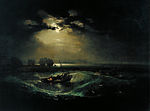 | Рыбаки в море | 1796 | Холст, масло | 91,4 x 122,2 | Тейт Британия |
| Трансепт монастыря Эвени в Гламорганшире | 1797 | Акварель | 40 х 55,9 | Национальный музей Кардиффа | |
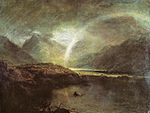 | Buttermere Lake, with Part of Cromackwater, Cumberland | 1798 | Холст, масло | 88,9 x 119,4 | Тейт Британия |
 | Автопортрет | 1799 | Холст, масло | 74,3×58,4 | Тейт Британия |
 | Голландские лодки в бурю. Рыбаки перекладывают рыбу на корабль | 1801 | Холст, масло | 162,5 × 222 | Частная коллекция |
 | Фирвальдштетское озеро | 1802 | Акварель | 30,5 × 46,4 | Тейт Британия |
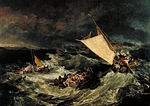 | Кораблекрушение | 1805 | Холст, масло | 170,5 x 241,6 | Тейт Британия |
| Трафальгарское сражение, вид с вантов бизань-мачты по правому борту корабля «Виктори» | 1806-1808 | Холст, масло | 172,7×238,8 | Тейт Британия | |
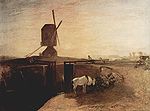 | Большой соединительный канал близ Саутол-Милл | 1810 | Холст, масло | 92 x 122 | Частная коллекция |
 | Снежная буря. Переход Ганнибала через Альпы | 1810-1812 | Холст, масло | 146 x 237,5 | Тейт Британия |
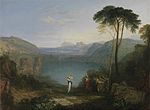 | Озеро Аверн: Эней и дух | 1814-1815 | Холст, масло | - | Йельский центр британского искусства, собрание Пола Меллона, США. |
 | Дидона, основательница Карфагена | 1815 | Холст, масло | 155,5 х 232 | Лондонская национальная галерея |
| Извержение Везувия | 1817 | Холст, масло | 28,6 х 39,7 | Йельский центр британского искусства, Нью-Хейвен, Коннектикут. | |
 | Церковь Святого Петра с юга | 1819 | Акварель | 22,8 × 36,8 | Британский музей |
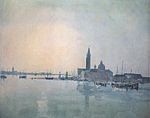 | Сан-Джорджо Маджоре: раннее утро | 1819 | Акварель | 22,4х28,7. | Тейт Британия |
| Радуга над замком Арундель | 1824 | Акварель | 70 × 52,6 | Британский музей | |
| Стоунхендж | 1828 | Акварель | 76,5 × 53,2 | Частная коллекция | |
 | Улисс насмехается над Полифемом | 1829 | Холст, масло | 132,5 х 203 | Лондонская национальная галерея |
 | Закат в парке Петворта | 1830 | Холст, масло | 63,5 × 139 | Тейт Британия |
 | Горящее судно | 1830 | Акварель | 49 × 34 | Тейт Британия |
| Гранд-Канал | 1835 | Холст, масло | 91 × 122 | Метрополитен-музей | |
 | Пожар английского парламента | 1835 | Холст, масло | 92,7 × 123 | Художественный музей Кливленда |
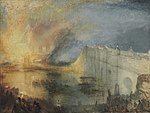 | Пожар в верхней и нижней палате английского парламента | 1835 | Холст, масло | 92,5 × 123 | Художественный музей Филадельфии |
| Последний рейс корабля «Отважный» | 1839 | Холст, масло | 91×122 | Лондонская национальная галерея | |
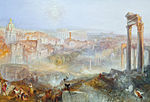 | Современный Рим — Кампо Ваччино | 1839 | Холст, масло | 90,2×122 | Музей Гетти |
 | Констанц на Боденском озере | 1842 | Акварель | 247,3 × 183,4 | Британский музей |
| Свет и цвет | 1843 | Холст, масло | 78,7 × 78,7 | Тейт Британия | |
 | Дождь, пар и скорость | 1844 | Холст, масло | 91×121,8 | Лондонская национальная галерея |
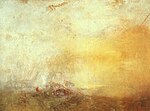 | Восход с морскими чудовищами | 1845 | Холст, масло | 91,5×122 | Тейт Британия |
www.gpedia.com






